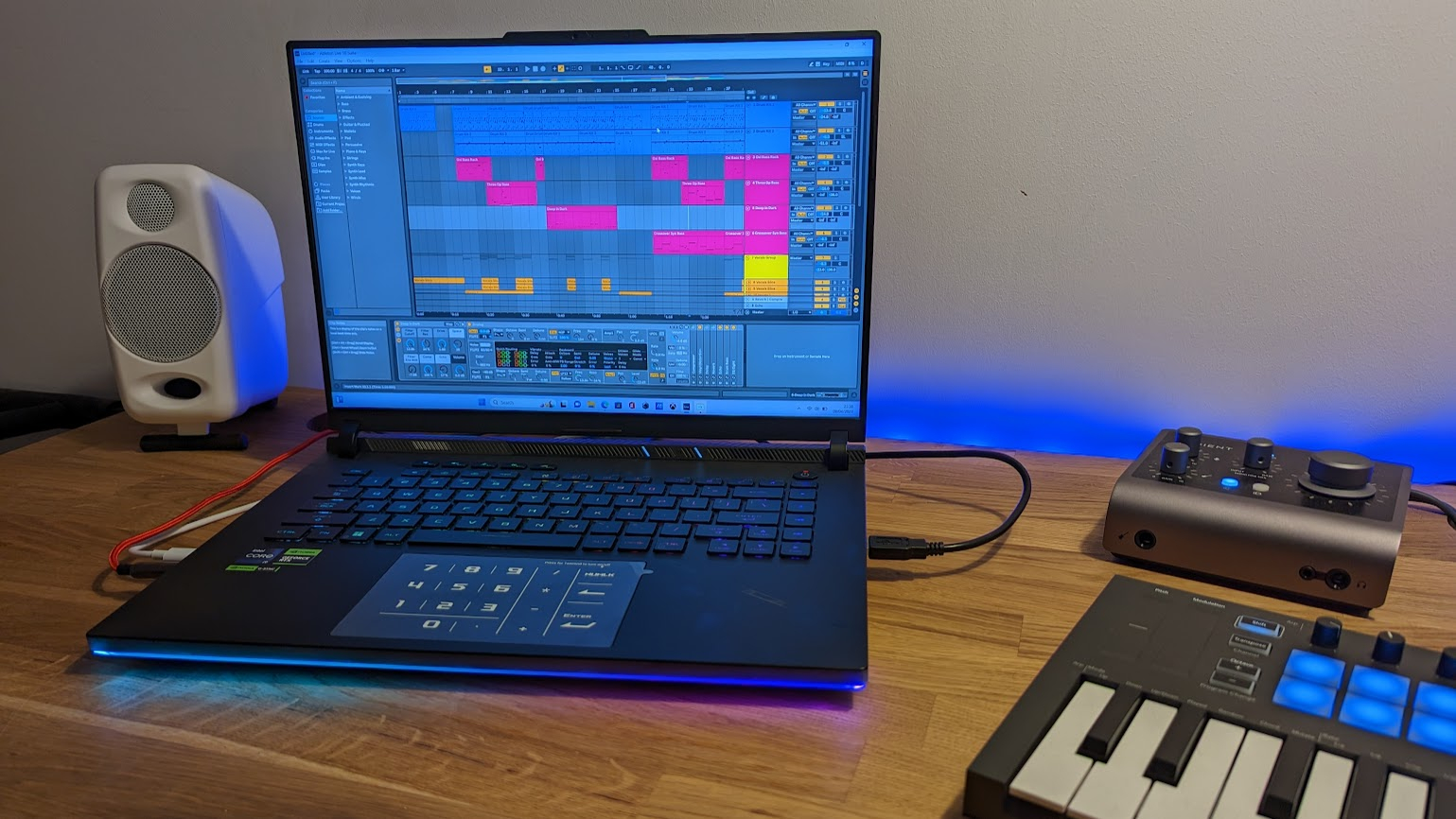MusicRadar Verdict
The Asus Strix Scar 16 is, objectively, an elite laptop. It has more in the way of performance capabilities than you will likely ever need as a musician or producer, so the more sensible question is whether it will offer you good value. If you’re a gamer and producer looking for a machine that will do everything, then absolutely. The Strix Scar 16 will make you extremely happy. For musical pursuits alone, however, there are probably better options.
Pros
- +
A joy to use in every way
- +
Fast, responsive operations
- +
Beautiful screen
Cons
- -
Looks may be subjective
- -
Higher power settings are energy hungry
MusicRadar's got your back
Asus Strix Scar 16 review: What is it?
At its heart, the Asus Strix Scar 16 aims to occupy that same space in the laptop world that a Lamborghini Aventador does in the car world. Both serve up the pinnacle of spectacular high-end design, with the power, performance and sheer force of will to make even the most cynical reviewer crack a smile. But does the average music producer need this much power? Let’s explore in our review of the formidable Asus Strix Scar 16.
We’re all more than familiar, by now, with what makes a great laptop for music production. We’re looking for a CPU powerful enough so we’re not staring at progress bars for too long. We need a healthy amount of RAM for quick access to all those information-dense samples, along with a phalanx of rapid storage for saving our complex multi-track arrangements. We also need it to have enough connectivity for adding in our various external devices, like audio interfaces, control surfaces and storage.
The Asus Strix Scar 16 takes all of these requirements and runs with them as far as the eye can see. Our review model, for example, came with a 13th-Gen Intel i9 CPU, 32GB of DDR5 memory and 1TB of solid-state storage. The poor MacBook Air which I normally use got extremely self-conscious sat next to it. Additionally, being a gaming laptop, there was an NVIDIA RTX 4080 graphics card driving a 16” HDR screen at up to 240 frames per second. Alongside this, the usual cavalcade of ‘edgy’ visual stylings and RGB lighting left me with no doubt the Strix Scar is aimed at a very specific kind of user.
That kind of user is, undoubtedly, gamers. But, as musicians and producers, can the Asus Strix Scar 16 make sense as a viable option for the studio? Let’s take a look.
Asus Strix Scar 16 review: Performance & verdict
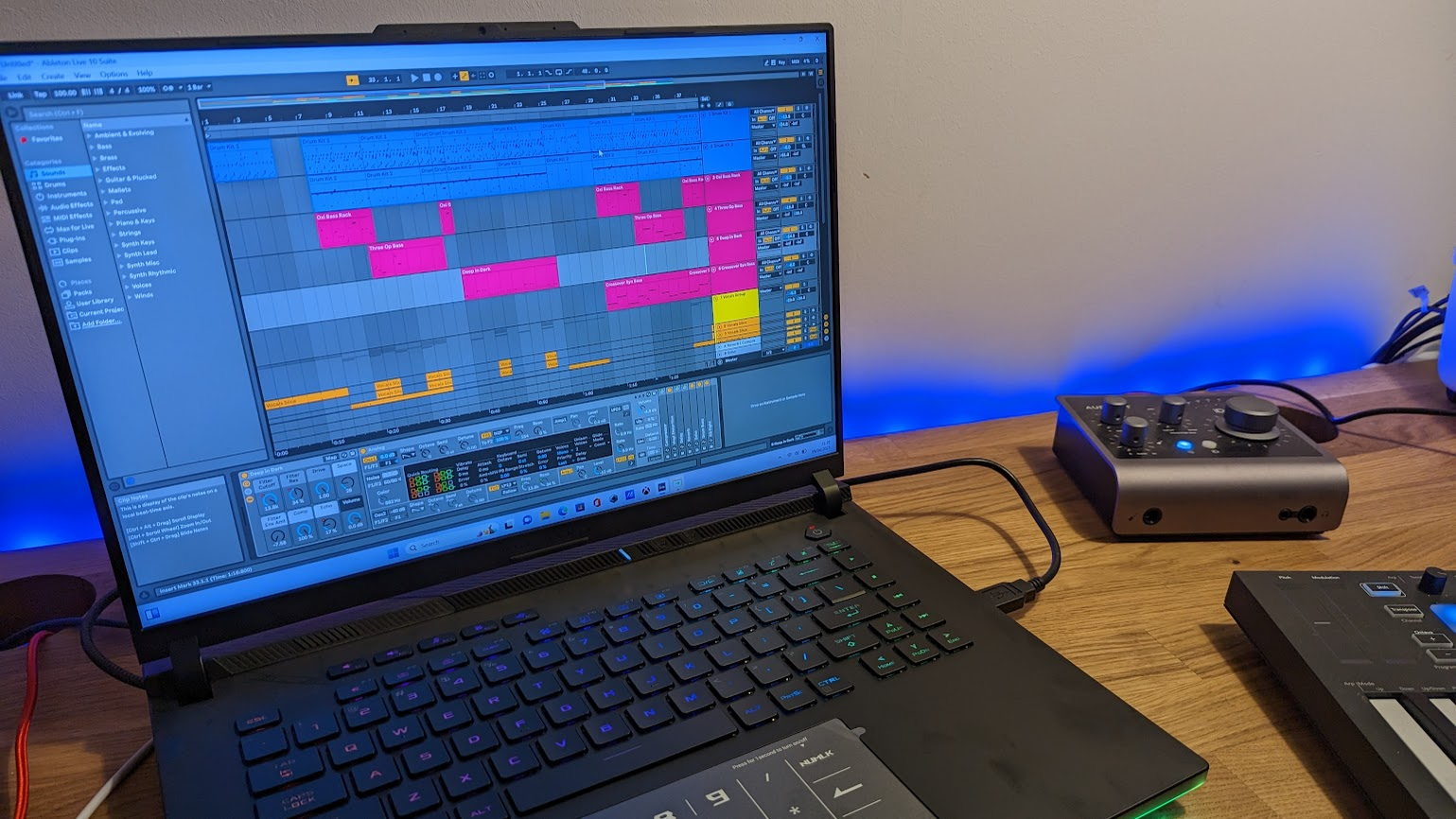
First point of call when reviewing any kind of laptop, particularly one from the top tier, is to install a Live licence and begin throwing plugins, virtual instruments and sample packs at it to find its breaking point. Well, reader, I can tell you that after loading a session with 10 tracks of NI Battery instances, the same number of Kontakt tracks, and a bunch of other audio, MIDI and automation tracks, the Strix Scar didn’t bat an eyelid so I gave up. Performance isn’t even a question here, folks. This is a high-grade laptop, and I can say with confidence that you’ll struggle to overwhelm it no matter what you’re trying to do.
Linked to performance, however, is system noise. Often when you use high-powered computing gear, you’ll find it needs equally powerful cooling systems to ensure its insides don’t melt. The Strix Scar 16 does a great job at providing enough airflow to deliver a decent level of natural aspiration, with the fans only kicking in when things got particularly onerous. Even when they did, we didn’t find them overly loud, certainly when compared with our older Intel-based MacBook Pro.
Sticking with noises, we know musicians likely aren’t going to be using the built-in speakers for anything other than system sounds, however, we did find they had an above-average level of bass response. This was counterbalanced, however, by the fact that having the volume anywhere above 50% made anything - everything, in fact - sound like someone standing at the bottom of a well clanging machinery together. Not ideal, but then you’ll probably be using headphones and/or monitor speakers so not a deal-breaker.
The trackpad is among the best I’ve ever used. Surprisingly good, in fact. It’s responsive to a level I’ve never seen on a Windows laptop before, offering up a degree of fine-tuned precision that is equally at home making minuscule adjustments to a VST filter cutoff as it is sniping Cabal Centurions in Destiny 2.
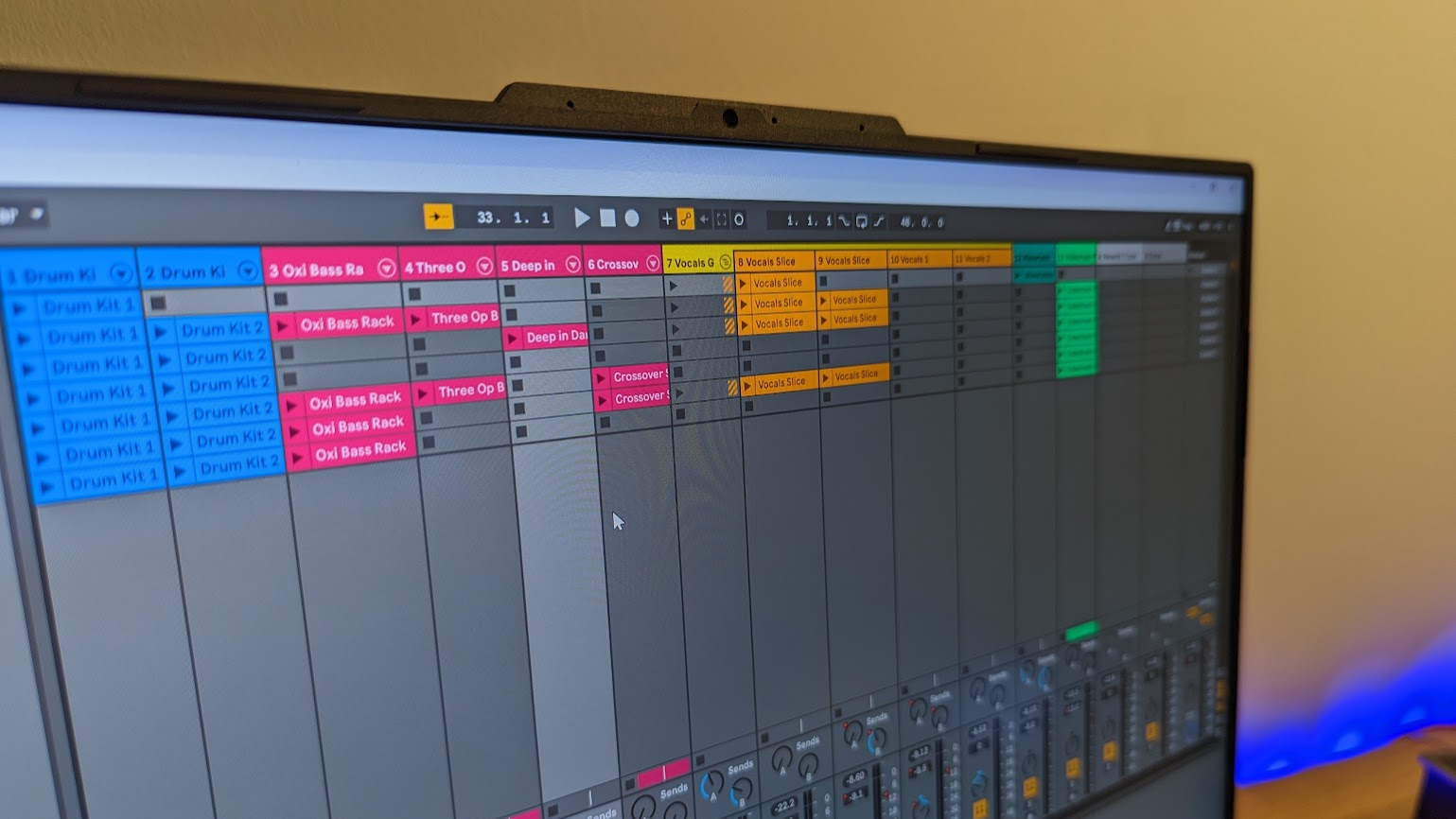
On the left side of the Strix, you’ll find a couple of USB-C connections, along with an HDMI output, a 3.5mm headphone/mic combo and the PSU connection. Special mention to the power supply itself, which is among the biggest, most masculine charging units I’ve ever seen, weighing in around the same as a small family car. This is not, it must be said, the laptop to choose if high energy bills are a concern. Battery life is passable, with a stated average of around 8 hours, but naturally this figure will drop dramatically depending on how you’re using it.
To the right, there are a couple more USB-2 connections for good measure. What irked me slightly is how the connections - particularly the power supply - are at the side, rather than at the back of the machine. I know it’s standard practice in laptops to have USB connections at the side, and airflow is a concern. Perhaps it's linked to my unhealthy obsession with studio aesthetics too, but with the cables and wires all connected up, the Strix did begin to resemble a cyberpunk octopus.
We can’t have a review of a laptop like this and not look at the price. Our review spec model comes in north of £/$3,000. This is not a cheap laptop, clearly. If you’re looking at this end of the market, you’ll already be aware of the numbers we’re talking about though so let’s instead frame the narrative around value, as opposed to the number on the price tag. Does the Asus Strix Scar 16 offer you, the user, good value when viewed through the lens of music-making?
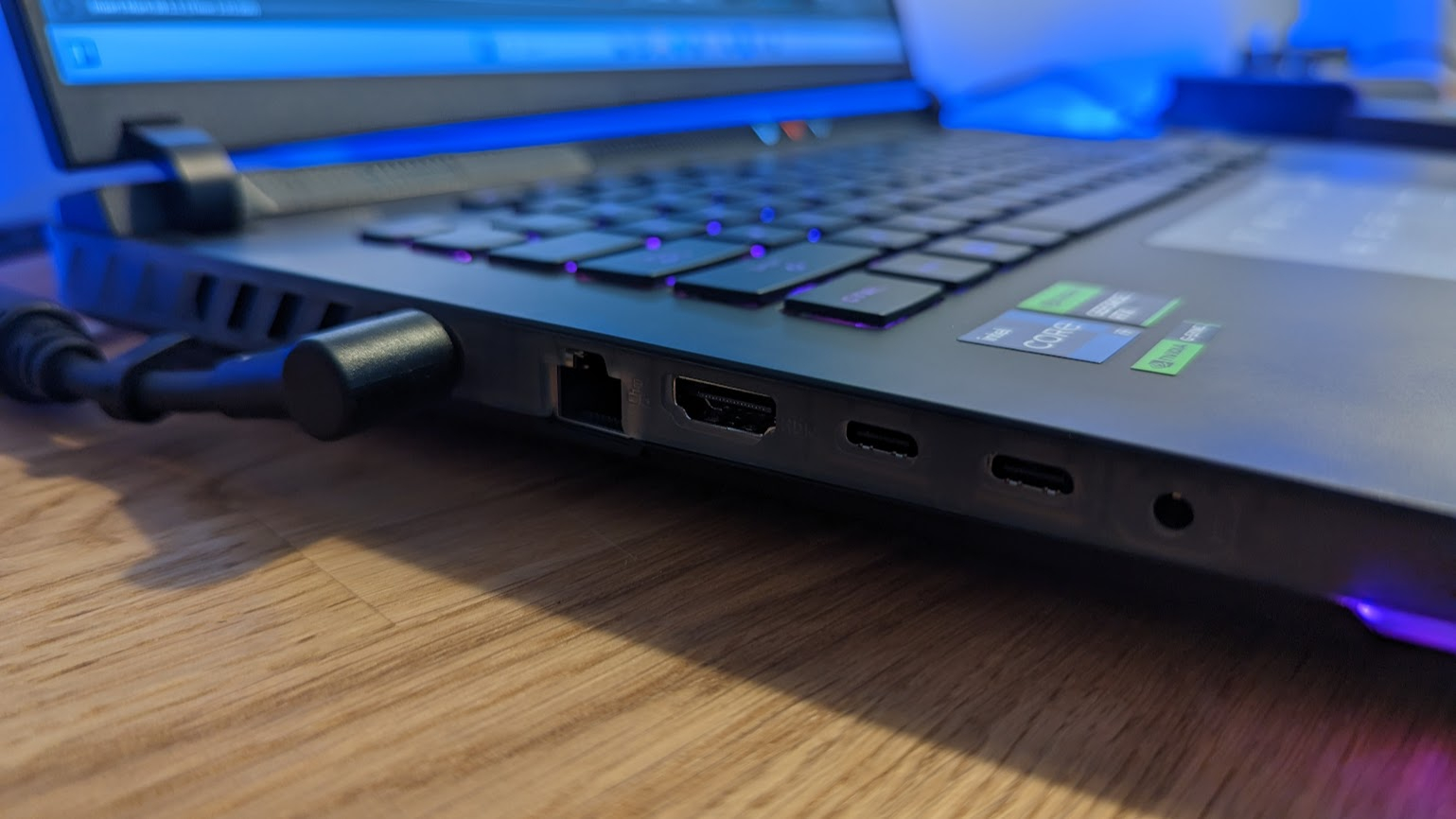
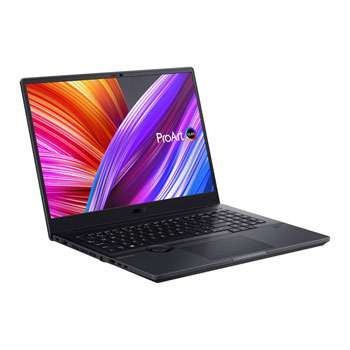
Asus Studiobook 16 OLED
Apple MacBook Pro 16
Dell XPS 15 9520
Honestly, not really. A big chunk of that heavy price tag is justified by the inclusion of that near-flagship NVIDIA RTX 4080 graphics card which unlocks the full potential of the accompanying 240Hz mini-LED screen. Do you, as a musician or producer, need that amount of graphical processing power to navigate around your timeline on Live? Probably not, but if you count gaming and music-making as dual passions, or perhaps videography and content creation, and want a machine that can do each to a high level, then sure. This is a beast of a machine, which will serve you well for years to come.
If however, the gaming element doesn’t count as a key decision factor, then a more direct comparison might come from Asus’ own stable, in the Studiobook 16 OLED. It matches the Strix Scar in the ways a musician or producer would want it to, i.e. in the base-level grunt of it, yet does so without the more gaming-specific attributes of the Strix.
In conclusion, the Asus Strix Scar 16 is, in many ways, the pinnacle of performance computing. It’s fast, reliable and has the potential to astound you in the right circumstances. You’ll know if you are likely to benefit from all that additional gaming-specific functionality, and you’ll also know in your heart of hearts if it’s all a bit overkill. In many ways, it’s like recommending premium scuba gear, or high-end pizza ovens. For the right person, absolutely. For the majority? Not so much.
Asus Strix Scar 16 review: Hands-on demos
SuperSaf
Tech With Sean
TechniQualities
Asus Strix Scar 16 review: Specifications
- CPU: 13th-Gen Intel i9
- RAM: Up to 64GB DDR5
- Storage: Up to 4TB SSD
- Graphics: Up to NVIDIA RTX 4090
- Screen: 16” QHD+ Mini LED
- Weight: 2500g
- Contact: Asus
Chris Corfield is a journalist with over 12 years of experience writing for some of the music world's biggest brands including Orange Amplification, MusicRadar, Guitar World, Total Guitar and Dawsons Music. Chris loves getting nerdy about everything from guitar and bass gear, to synths, microphones, DJ gear and music production hardware.
“I’m looking forward to breaking it in on stage”: Mustard will be headlining at Coachella tonight with a very exclusive Native Instruments Maschine MK3, and there’s custom yellow Kontrol S49 MIDI keyboard, too
MusicRadar deals of the week: Enjoy a mind-blowing $600 off a full-fat Gibson Les Paul, £500 off Kirk Hammett's Epiphone Greeny, and so much more
